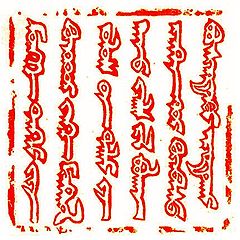- Traditional Mongolian alphabet
-
Mongolian alphabet
ᠮᠣᠩᠭᠣᠯ ᠪᠢᠴᠢᠭ
Type Alphabet Languages Mongolian Time period ca. 1204 – present Parent systems Proto-Sinaitic alphabet- Phoenician alphabet
- Aramaic alphabet
- Syriac alphabet
- Sogdian alphabet
- Old Uyghur alphabet
- Mongolian alphabet
- Old Uyghur alphabet
- Sogdian alphabet
- Syriac alphabet
- Aramaic alphabet
Sister systems Manchu alphabet
Oirat alphabet (Clear script)
Buryat alphabet
Galik alphabet
Evenki alphabet
Xibe alphabetISO 15924 Mong, 145 Direction Left-to-right Unicode alias Mongolian Unicode range U+1800 – U+18AF Note: This page may contain IPA phonetic symbols. This article is about the traditional alphabet used specifically to write Mongolian. For the family of Mongolian-derived alphabets, see Mongolian script.The traditional or classical Mongolian alphabet, sometimes called Hudum 'traditional' in Oirat in contrast to the Clear script (Todo 'exact'), is the original form of the Mongolian script used to write the Mongolian language. It fails to distinguish several vowels (o/u, ö/ü, final a/e) and consonants (t/d, k/g, sometimes ž/y) that were not required for Uyghur, which was the source of the Mongol (or Uyghur-Mongol) script.[1] The result is somewhat comparable to the situation of English, which must represent ten or more vowels with only five letters and uses the digraph th for two distinct sounds. Ambiguity is sometimes prevented by context, as the requirements of vowel harmony and syllable sequence usually indicate the correct sound. Moreover, as there are few words with an exactly identical spelling, actual ambiguities are rare for a reader who knows the orthography.
Letters have different forms depending on their position in a word: initial, medial, or final. In some cases, additional graphic variants are selected for visual harmony with the subsequent character.
Contents
Letters
Characters Transliteration Notes initial medial final Latin Cyrillic 



a А Distinction usually by vowel harmony (see also q/γ and k/g below) 
e Э 
 [note 1]
[note 1]

i, yi И,Й, Ы, Ь At end of word today often absorbed into preceding syllable 

o, u О, У Distinction depending on context. 
ö, ü Ө, Ү Distinction depending on context. 
 [note 3]
[note 3]


n Н Distinction from medial and final a/e by position in syllable sequence. 

ng Н, НГ Only at end of word (medial for composites).
Transcribes Tibetan ང; Sanskrit ङ.




b Б, В In classical Mongolian v is used only for transcribing foreign words, so most "В (V)" in Cyrillic Mongolian correspond to "Б (B)" in Classical Mongolian. 


p П Only at the beginning of Mongolian words.
Transcribes Tibetan པ;



q Х Only with back vowels 




γ Г Only with back vowels.
Between vowels pronounced as a long vowel in oral Mongolian.[note 5] The "final" version only appears when followed by an a written detached from the word.


k Х Only with front vowels, but 'ki/gi' can occur in both front and back vowel words
Word-finally only g, not k.g between vowels pronounced as long vowel.[note 6]

g Г 


m М 


l Л 


s С 


š Ш 



t, d Т, Д Distinction depending on context. 

č Ч, Ц Distinction between /tʃ'/ and /ts'/ in Khalkha Mongolian. 

j Ж, З Distinction by context in Khalkha Mongolian. 


y -Й, Е*, Ё*, Ю*, Я* 


r Р Not normally at the beginning of words.[note 7] 

v В Used to transcribe foreign words (Originally used to transcribe Sanskrit व) 


f Ф Used to transcribe foreign words 


ḳ К Used to transcribe foreign words 

(c) (ц) Used to transcribe foreign words (Originally used to transcribe Tibetan /ts'/ ཚ; Sanskrit छ) 

(z) (з) Used to transcribe foreign words (Originally used to transcribe Tibetan /dz/ ཛ; Sanskrit ज) 

(h) (г, х) Used to transcribe foreign words (Originally used to transcribe Tibetan /h/ ཧ, ྷ; Sanskrit ह) 
(zh) (-,-) Transcribes Chinese 'zhi' - used in Inner Mongolia 
(ř) (-,-) Transcribes Chinese 'ri' - used in Inner Mongolia 
(chi) (-,-) Transcribes Chinese 'chi' - used in Inner Mongolia Notes:
- ^ Following a consonant, Latin transliteration is i.
- ^ Following a vowel, Latin transliteration is yi, with rare exceptions like naim ("eight") or Naiman.
- ^ Character for front of syllable (n-<vowel>).
- ^ Character for back of syllable (<vowel>-n).
- ^ Examples: qa-γ-an (khan) is shortened to qaan unless reading classical literary Mongolian. Some exceptions like tsa-g-aan ("white") exist.
- ^ Example: de-g-er is shortened to deer. Some exceptions like ügüi ("no") exist.
- ^ Transcribed foreign words usually get a vowel prepended. Example: Transcribing Русь (Russia) results in Oros.
Examples
Manuscript Type Transliteration
(first word)


v 
i 
k 
i 
p 
e 
d 
i 
y 
a - transliteration: Vikipediya čilügetü nebterkei toli bičig bolai.
- Cyrillic: Википедиа Чөлөөт Нэвтэрхий Толь Бичиг Болой.
- Transcription: Vikipedia chölööt nevterkhii toli bichig boloi.
- Gloss: Wikipedia free omni-profound mirror scripture is.
- Translation: Wikipedia is the free encyclopedia.
References
- ^ György Kara, "Aramaic Scripts for Altaic Languages", in Daniels & Bright The World's Writing Systems, 1994.
External links
- Lingua Mongolia: Mongolian Alphabet, including tutorial
Inner Mongolia topics Hohhot (capital) General Geography Education Culture Music of Mongolia • Mongolian language • Mongolian script • Northeastern Mandarin • Plain Blue BannerCuisine Visitor attractions Categories:- Classical Mongolian alphabet
- Mongolian writing systems
- Phoenician alphabet
Wikimedia Foundation. 2010.
